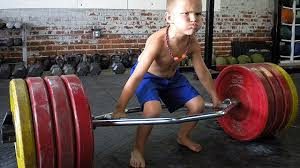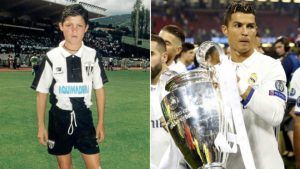Dear parents of young athletes,
I know you want your child to be the best, so I can understand why you like to watch training videos of world-class athletes so you can have him/her do what they’re doing. You’re probably assuming that whatever the best athletes are doing is what your child should be doing, so they will end up like them. 
I get it. And, I know you just want to give your child the best, so they can be their best.
Unfortunately, it seems like you’re missing one key component here – your child isn’t a world-class athlete yet, so he/she has different needs.
World class athletes train a certain way because they have built a solid foundation of movement, strength, mobility, work capacity, power, skill, etc. Their needs are more about refinement than development, so their training is very different than what they did when they were younger and trying to get to where they are today.
 Instead of looking at what the pros are doing NOW, look at what they did when they were your kid’s age. This will give you insight into what helped them develop the foundation of athleticism they have today.
Instead of looking at what the pros are doing NOW, look at what they did when they were your kid’s age. This will give you insight into what helped them develop the foundation of athleticism they have today.
Most world-class athletes participated in many sports/activities when they were young. They typically engaged in more hours of various activities than less successful athletes, but they almost always did it because they loved it. Athletes who achieve high levels of success have an internal drive at a young age to play sports. They wanted to go to the back yard or playground and practice because that’s what they loved doing.
You can also look at professional sports clubs in other parts of the world where they start developing athletes at a young age. In addition to playing plenty of soccer with amazing coaches, European soccer clubs have young kids doing all sorts of different activities like gymnastics, calisthenics, etc. that essentially act as their “second sport.” Those coaches have seen the process play out through many years of coaching, and they don’t want their young athletes doing the same movements over and over again because it leads to injuries and a lack of overall athletic development.
They don’t do these same things with their elite players because they understand that athletes at different ages/levels need different things. The older athletes are lifting weights, doing structured speed work, and in the case of their elite professionals, fine-tuning their bodies to ensure longevity and optimal performance. Training changes at each level because the needs are different. 
So, while it’s really interesting to watch videos of Stef Curry, Usain Bolt, Mike Trout, and Cristiano Ronaldo training, try to remember that they have very different needs than your child. What you see them doing now is not what they did when they were your child’s age, so it would be inappropriate for you to copy their training programs.
Instead, focus on fundamental motor skills, give them physical activities outside of their main sport, keep sports fun, and teach them to value the slow process of constant improvement. Have them play other sports, and let them explore the full capacity of their bodies. While you might not see the payoff this weekend, this is the path that most world-class athletes took, so have patience, and enjoy the experience of watching your young athlete slowly develop.
Sincerely,
Jim
 Jim Kielbaso is the President of the IYCA and owner of Impact Sports Performance in Michigan. He has authored multiple books, articles and training products and has spoken at events around the world. He holds a BS in Exercise Science, an MS in Kinesiology and has gone through multiple certifications through the IYCA, NSCA, NASM and more. Jim is a former college strength & conditioning coach and has trained thousands of athletes at every level of competition. He runs a successful NFL Combine training program in Michigan and has been hired as a consultant for major sports programs like the University of Michigan Football Program and the University of Kentucky Basketball Program.
Jim Kielbaso is the President of the IYCA and owner of Impact Sports Performance in Michigan. He has authored multiple books, articles and training products and has spoken at events around the world. He holds a BS in Exercise Science, an MS in Kinesiology and has gone through multiple certifications through the IYCA, NSCA, NASM and more. Jim is a former college strength & conditioning coach and has trained thousands of athletes at every level of competition. He runs a successful NFL Combine training program in Michigan and has been hired as a consultant for major sports programs like the University of Michigan Football Program and the University of Kentucky Basketball Program.

